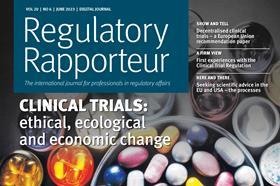
EDITORIAL: In the pursuit of global – or even regional? – standards in requirements to support medical product development; is industry keeping up? Can regulations and guidelines keep up with the pace of change?

Regulatory Rapporteur
June 2023 | Volume 20 | No.6
Thomas L Friedman in his book: ‘The World is Flat: A Brief History of the Twenty-first Century’ talks about the spread of globalisation and how essentially the world ‘flattened’ into one interconnected place through the spread and exchange of cultures, ideas, information, trade and industry.
The past few decades have been a time for rapid globalisation in the development of medical products and technologies. Demand has grown for globally harmonised, science-based standards for the development and evaluation of safety, quality and efficacy/effectiveness of medical products. The goal is to provide clarity to those researching new medical products on the development pathway and evaluation process as well as improving the efficiency of these programs to ensure greater access to those medical products for all.
The broader question then is whether industry is keeping up with the pressures arising from innovation, technology, patient-centricity, inclusivity, accessibility and sustainability – ethical and ecological – which are driving the pursuit of global standards in requirements to be able to provide some stability in such economically volatile times.
…driving the pursuit of global standards in requirements to be able to provide some stability in such economically volatile times…
In this issue of Regulatory Rapporteur, we have four topical focus articles that explore some of the issues outlined above.
The first article focuses on decentralised trials (DCTs), which are studies that make use of digital tools such as e-consent, apps, wearable devices, etc and approaches where aspects of the trial may occur outside of the investigational site to provide a more patient-centric focus to clinical trials. Many clinical trials have adopted elements of DCT, the COVID-19 pandemic bought many of these elements together to minimise disruption to clinical research. Irrespective of any health-related crisis, and as part of the Accelerating Clinical Trials in the EU, the EMA has released a recommendation paper on how these DCT elements can be incorporated into broader clinical trial settings.
We have two articles on experiences with the European Clinical Trials Regulation (EU CTR), one from a company perspective and one from the CRO perspective. The EU CTR came into force on 31 January 2022, and we are now in the second year of transition. The aim of the regulation was to ensure the highest standards of safety for clinical trial participants, to harmonise the approval process and to strengthen transparency and consistency. The effective date was reliant on the availability of a single electronic EU portal and database – clinical trials information system (CTIS) – as a resource to support the submission and sharing of information between the sponsors, regulators and the public.
While the aim of the regionalisation of standards to support clinical trials in the EU were welcomed, the ambitions of the CTIS system have not yet transpired due to technical and functionality issues and its inability to cope with the demands of the volume of users and data being shared across the platform. Industry associations are keeping a keen eye on whether the platform continues to remain stable as the volumes increase as legacy trials initiated under the old Clinical Trial Directive are transitioned into the new standard required under the Regulation.
Finally, we have an article comparing the processes of seeking scientific advice (SA) in the EU and USA. SA – when sought at the appropriate time of development – provides valuable insight to developers on the expectations of regulators on the data package required to support a successful product launch. The article examines not only those key regulatory agency SA procedures but also considers the parallel scientific advice procedure (EMA-FDA) and the pilot process for obtaining simultaneous national scientific advice (SNSA) from two EU agencies at the same time. These steps towards convergence of approach can only benefit industry as they strive to become more efficient, harness innovation and flatten some of the barriers and risks to medical product development around the globe.





















No comments yet